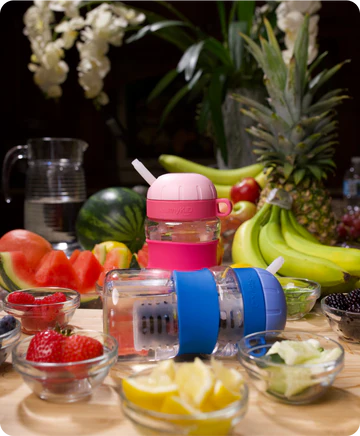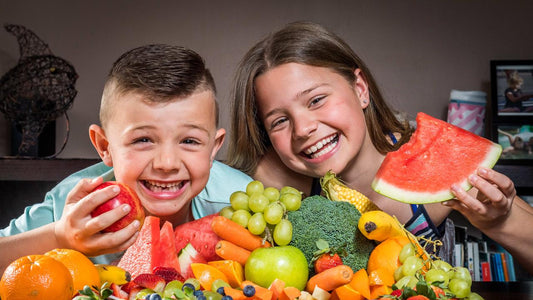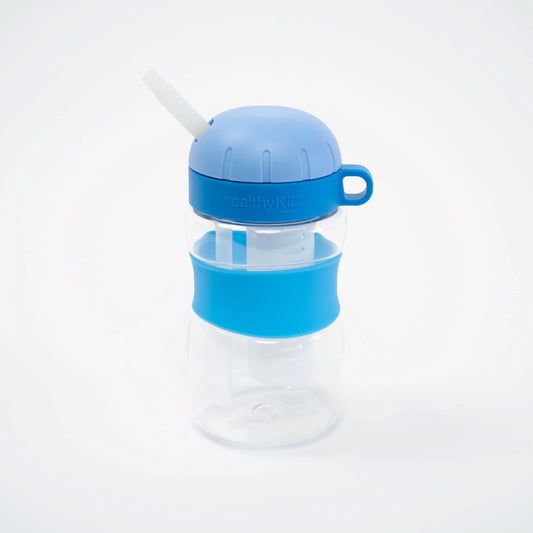Did you know that one third of all advertised children’s fruit drinks contain at least 16 grams of sugar? Surprisingly, this is more than half the maximum amount of sugar a child should consume in a day. Worst of all, many of these fruit drinks are advertised as “healthy” or “healthier” because they are fruit flavored.
So, what is 1 gram of sugar? A gram of sugar is nearly ¼ a tablespoon. So that CapriSun you may have in the fridge with 20 grams of sugar comes with 5 full tablespoons of sugar. Imagine giving 5 tablespoons of sugar to your child directly? In fact, many of the popular 6-ounce juice boxes all of us parents buy for our children have more than 20 grams of sugar per box. And according to nutritional guidelines, none of the drinks are healthy.
So why do us loving parents buy these products for our children? Why would loving parents do this? Maybe because these giant beverage companies spend hundreds of millions of dollars to advertise fun, family orientated, and an illusion of “healthy” commercials to us all every day.
Did you know that two-thirds of children’s fruit, sweetened drinks analyzed in the Children’s Drink Fact report contained no juice? But these companies still advertise images of fruit in their advertising and packaging. The fruit drinks which did contain juice, only had about 5% of juice.
Another myth or loophole in advertising are claims of “good source of Vitamin C” or 100% Vitamin C”. Yeah, these fruit juices typically have little or no juice as well. Another confusing advertising gimmick is “Low Sugar”. This just means they are adding chemical, artificial sweeteners that we don’t want our children to consume either.
I grew up drinking Kool Aid Jammers and Capri Sun Roarin, I still remember some of the commercials. Both of these drinks contain 0% juice but have pictures of fruit in their advertising and on their packaging. And take a look at your boxed apple juice drink, almost no natural ingredients and full of sugar. I was always told to limit my soda intake, maybe my parents should have said the same for apple juice.
There was a Research Report that shows parents do not want to give their children drinks with artificial sweeteners. However, almost 75% of the tested sweetened fruit drinks and flavored waters contained artificial sweeteners. Both sugar and artificial sweeteners were in nearly 40% of the fruit or flavored water beverages.
It is almost impossible for a non-chemist parent to know what is inside our fruit drinks, you have to read the ingredients list and see how much juice is in it, look at the sugar grams, and the artificial sweeteners.
Most parents will recognize the chemical names for sweeteners. We listed the most popular chemical sweeteners here:
- aspartame
- acesulfame-potassium
- sucralose
- stevia
- neotame
- saccharin
It is recommended that all kids 5 and under should avoid drinking flavored milks, plant-based/non-dairy milks, caffeinated beverages and sugar or low-calorie sweetened beverages.
Let’s surprise ourselves and look at the sugar content in some of the most popular drinks we buy for our children (*per 8-oz serving):
- Nesquik Strawberry Milk (29.59 grams sugar - more than 8 Chips Ahoy cookies!)
- Kool-Aid Jammers - Blue Raspberry (25.33 grams sugar - more than a full-size Hershey's chocolate bar)
- MinuteMaid Fruit Punch (5% juice blend; 25 grams sugar)
- CapriSun (20 grams sugar)
- Hi-C Orange Lavaburst (21 grams sugar)
- Hawaiian Punch Berry Limeade Blast (17 grams sugar)
- SunnyD (3% juice; 14 grams sugar)
- Hawaiian Punch Fruit Juicy Red (14 grams sugar)
- Honest Kids Goodness Grapeness (10 grams sugar)
- Motts for Tots Apple Juice (15 grams sugar)
Healthy Kid’s Fruit Infused Bottle for Toddlers and Children
So what is the alternative? Water? We all know water is free of sugar, fats, and additives and the best solution to keep our children hydrated. But you may ask yourself “Buy my toddler doesn’t think water is very fun?”.
These questions and this article is one of the reasons we designed the Healthy Kid Fruit Infused bottle for toddlers and children. It all started when my husband and I started drinking a lot of fruit infused water this summer. We would make recipes, chop fruit, and it became a routine that was fun as well as healthy.
Our twin toddlers always wanted to try our fruit infused water, and it became an easy way for them to even eat their fruit after. We also thought the fruit infused water was a great alternative to store-bought juices (explained above). Our kids were drinking more water, they loved the taste, and they were naturally consuming a lot of vitamins and antioxidants.
One morning, our twin toddlers woke up and asked us for “fruit water”. This was beginning which led to the inspiration to make the Healthy Kid fruit infuser for toddlers and children. As adults, we have numerous options to buy a fruit infuser bottle, but surprisingly for toddlers and children there were none.
Let me explain how the Healthy Kid Fruit Infuser bottle works.


